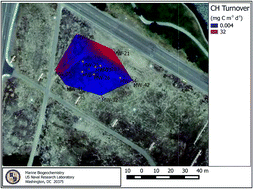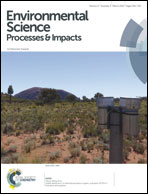Combined radiocarbon and CO2 flux measurements used to determine in situ chlorinated solvent mineralization rate†
Abstract
A series of combined measurements was made at the Naval Air Station North Island (NASNI) Installation Restoration Site 5, Unit 2 during July and August 2013. Combined measurements included CO2 respiration rate, CO2 radiocarbon content to estimate chlorinated hydrocarbon (CH) mineralization and a zone of influence (ZOI) model. CO2 was collected continuously over 2 two-week periods by recirculating monitoring well headspace gas through NaOH traps. A series of 12 wells in the main CH plume zone and a background well with no known historical contamination were sampled. The background well CO2 was used to determine radiocarbon content derived from respired natural organic matter. A two end-member mixing model was then used to determine the amount of CH-derived carbon present in the CO2 collected from plume region wells. The ZOI model provided an estimate for the soil volume sampled at each well. CH mineralization rates were highest upgradient and at the plume fringe for areas of high historical contamination and ranged from 0.02 to 5.6 mg CH carbon per day. Using the ZOI model volume estimates, CH–carbon removal ranged from 0.2 to 32 mg CH–carbon m−3 per day. Because the rate estimates were based on a limited sampling (temporally), they were not further extrapolated to long-term contaminant degradation estimates. However, if the site manager or regulators required them, estimates – subject to long-term variability uncertainties – could be made using volume and rate data determined over short timescales. A more comprehensive seasonal sampling is needed to constrain long-term remediation models for the entire impacted area and identify environmental conditions related to more rapid turnover times amongst the wells.


 Please wait while we load your content...
Please wait while we load your content...